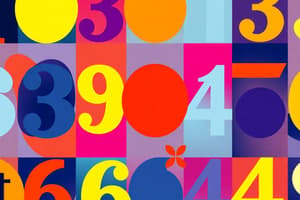Podcast
Questions and Answers
What does the numerator of a fraction represent?
What does the numerator of a fraction represent?
- The value of the fraction
- The denominator of the fraction
- The number of parts being considered (correct)
- The total number of equal parts
How can fractions be simplified?
How can fractions be simplified?
- By finding common factors between the numerator and denominator (correct)
- By changing the denominator to a smaller number
- By changing the numerator to a smaller number
- By increasing both the numerator and denominator
What role do rational numbers play in mathematics?
What role do rational numbers play in mathematics?
- Representing only whole numbers
- Showing irrational relationships
- Enabling accurate measurement and comparison of quantities (correct)
- Being used for complex calculations only
On the number line, where are fractions with larger denominators located in relation to fractions with smaller denominators?
On the number line, where are fractions with larger denominators located in relation to fractions with smaller denominators?
What does the denominator of a fraction represent?
What does the denominator of a fraction represent?
What defines a rational number?
What defines a rational number?
What does the fraction 5/6 represent?
What does the fraction 5/6 represent?
How are rational numbers positioned on the number line?
How are rational numbers positioned on the number line?
Which type of numbers can be expressed as fractions?
Which type of numbers can be expressed as fractions?
What does the decimal 0.5 represent in terms of a fraction?
What does the decimal 0.5 represent in terms of a fraction?
Which characteristic distinguishes rational numbers from other numbers?
Which characteristic distinguishes rational numbers from other numbers?
Flashcards are hidden until you start studying
Study Notes
Rational Numbers
Rational numbers are mathematical entities composed of integers and fractions. They make up a subset of real numbers and have several properties that distinguish them from other numbers. In this article, we will delve deeper into rational numbers, specifically examining their characteristics as well as their relationships with whole numbers and decimal numbers.
Properties of Rational Numbers
A rational number is any number that can be expressed as the ratio a/b of two integers a and b, where b does not equal zero. Two properties that characterize rational numbers are their ability to represent ratios of whole objects and their position on the number line.
Represent Ratios
Rational numbers can represent ratios of whole objects. For example, a fraction like 3/4 represents a ratio of three parts to four parts. Likewise, the decimal representation 0.75 also illustrates the same ratio of three parts to four parts. Both of these mathematical expressions are examples of rational numbers.
Position on Number Line
Rational numbers have a specific position on the number line. They can be arranged in increasing order, displaying their relationship relative to one another. This property allows for easy comparisons and calculations involving rational numbers.
Fractions
A fraction represents a ratio of two integers. It consists of a numerator a (top number), indicating how many parts, and a denominator b (bottom number) representing the total number of equal parts. For example, the fraction 2/3 represents a ratio of two parts out of three equal parts.
Properties of Fractions
Some key properties of fractions include their ability to represent ratios, being represented on the number line, and having distinct values. Additionally, fractions can be simplified through common factors held by both the numerator and the denominator.
Conclusion
In conclusion, rational numbers play a crucial role in mathematics as they enable accurate measurement and comparison of quantities. Fractions are a specific type of rational number that represent ratios of whole objects, providing valuable insights into mathematical relationships. Understanding these concepts helps lay the foundation for further exploration of more complex mathematical ideas.
Studying That Suits You
Use AI to generate personalized quizzes and flashcards to suit your learning preferences.




